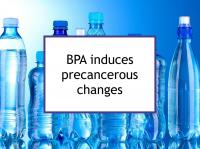Bisphenol A (BPA), a chemical that leaches from food containers during normal usage, has been reported to promote mammary tumor development and growth. However, some industry groups have maintained that BPA exposure is too low to cause such effects. Now a new study has reported that even miniscule BPA exposure induces precancerous changes in normal breast cells.
Sources of BPA exposure
BPA is one of the highest-volume chemicals produced worldwide; it can be detected in the body fluids of over 90% of the human population. Originally deliberately created as an estrogenic compound, it is now used as an industrial chemical in a wide variety of applications, including plastics manufacture.
For example, BPA is used to manufacture polycarbonate plastics found in plastic baby bottles, water bottles, and plastic containers. BPA is also found in various canned goods, where it leaches from the epoxy coatings used to prevent corrosion of can interiors. In addition to food cans, soda cans are often lined with plastics that contains BPA. BPA is pervasive in household dust and is also found on thermal cash register receipts. Consumer protections with respect to BPA are weak.
Latest research finds precancerous changes due to BPA
The study referenced above was designed to investigate the effects of BPA in normal breast tissue. To conduct the study, the authors used non-tumorigenic MCF10A cells, which were treated with 10 nM (10-9 mole per liter) BPA for 24 hours to discern early molecular changes preceding observable modifications in cell characteristics.
The authors conducted multiple RNA analyses to identify genes that were expressed differently and alterations in signaling pathways. These findings were validated by further studies. Analysis of the transcriptome (the totality of RNA transcripts in a cell) demonstrated that BPA exposure resulted in enrichment in interleukin signaling and activation of the NF-κB pathway (both known to influence breast cancer development). BPA also enhanced cell motility (the ability to move, which is required for metastasis), accompanied by increased phosphorylation of NF-κB and some cytoskeletal rearrangement. Inhibition of NF-κB effectively extinguished these BPA-induced effects.
The authors summarize that nanomolar concentration of BPA induce meaningful changes in breast cells, activating NF-κB signaling, which in turn regulates inflammation, cell cycle, proliferation and cell motility. The findings show that nanomolar concentrations of BPA can cause significant molecular and behavioral changes in breast epithelial cells, thereby potentially contributing to breast cancer development.
